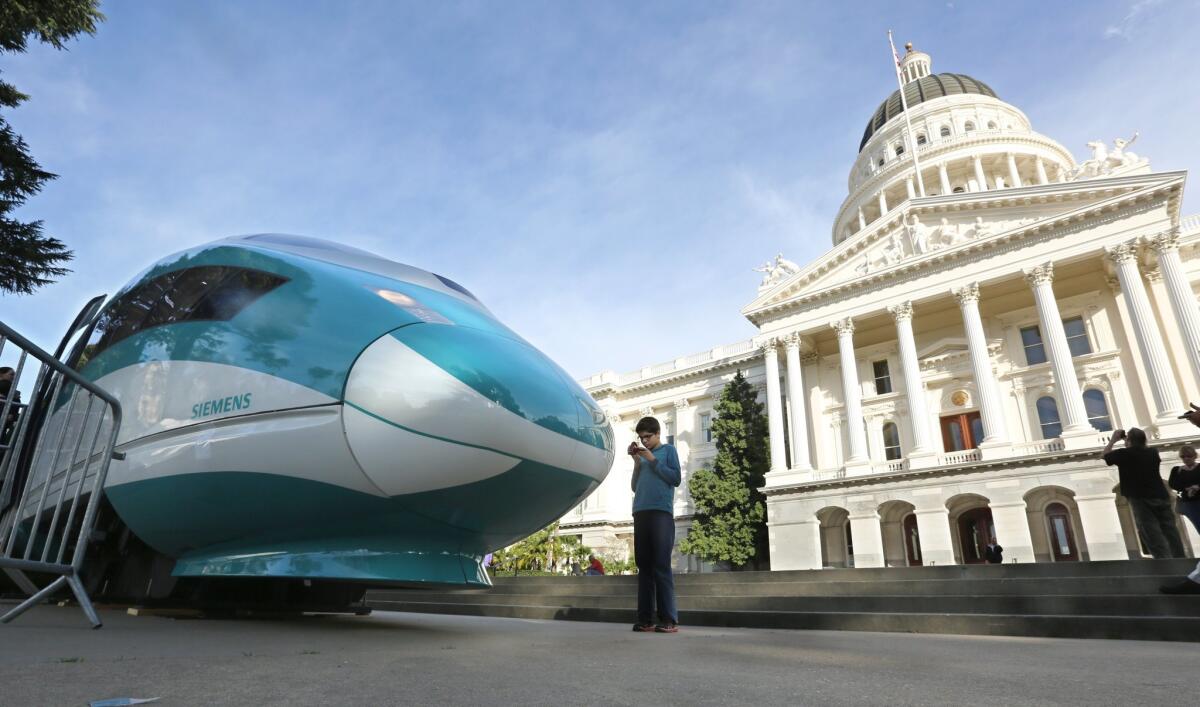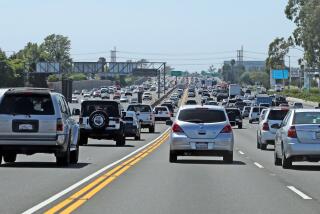Op-Ed: ‘Smart’ highways, not bullet trains, for California

A full-scale mock-up of a high-speed train is displayed at the Capitol in Sacramento on Feb. 26.
- Share via
The state’s $68-billion-plus high-speed rail project would have been a great idea — in the last century. In the 21st, there’s a better, cheaper, more California solution to moving people long distances: smart highways.
For an estimated $2 billion, we can add smart lanes to Interstate 5 in both directions between Los Angeles and San Francisco. For those keeping track, that’s 32 times less costly. And much of the necessary technology is being developed here in California. In contrast, while future high-speed trains might be built in the United States, the California High-Speed Rail Authority has asked for and received a waiver of the “Buy America” requirements for the first prototype trains.
Driverless cars and related technologies will arrive well before high-speed rail.
High-speed rail might be a good solution if we had a flat, unoccupied plot running from Los Angeles to San Francisco with no mountains, valleys and expensive land to purchase in the way. Obviously, we don’t. And even an ideal landscape wouldn’t solve the “last mile” problem — getting to and from the central rail stations. With rail, if you live far from the railhead (which almost everyone does), you need to drive through traffic to the central station, find a place to park and arrange transportation at the other end. But high-tech highways can have many entrances and exits and link up with the existing highway system.
In theory, modern railways have a speed advantage over modern highways. Not only would the bullet train travel faster than existing autos, it would also travel faster than computer-driven cars along certain stretches, notably from Los Angeles to San Jose, with a promised top speed of 220 mph. Along other stretches, however, including San Francisco to San Jose and Anaheim to Los Angeles, the train’s anticipated speed will be 110 mph. We have regular cars that can beat that now. Granted, we don’t allow cars to reach their top speeds due to safety concerns. But on a high-tech highway, computer-driven cars would be able to achieve high speeds routinely and safely.
Slower auto speed, moreover, would largely be offset by the highway advantage of where-you-want/when-you-want access. Taking a regular road to connect to a high-tech highway would almost always be more convenient, and less time-consuming, than driving to one of a limited number of central train stations.
The high-tech highway offers yet another plus that’s not often mentioned: Unlike rail, it’s not a one-size-fits-all solution run by a monopoly. Once highway lanes are added and standards are established for just how smart a vehicle has to be, anyone can go into the smart highway transit business. There will be small-business opportunities for renting and “driving” smart autos, smart vans, smart limos and smart buses. How about a 120-mph luxury bus trip with no driver but with a steward serving drinks and snacks? The Dutch have already built a prototype 23-passenger, electric-powered limo with cruising speeds of 160 mph.
The use of high-tech highways need not be limited to driverless vehicles. Current technology is very close to allowing high-speed cars and buses with just enough smarts (such as smart cruise control with lane-guidance technology) to “platoon” in reserved lanes. Packing vehicles tightly together as they travel would cut wind resistance enough to overcome energy efficiency issues, enabling at least some car models in current use to cruise at 120 mph.
It is no longer clear that high-speed rail will ever be built as originally envisioned, connecting “mega-regions of the state.” Rail officials having already cut high-speed service between Los Angeles and Anaheim and between San Jose and San Francisco. Even if we do complete a piece of the project, a piece that falls short of connecting the major north/south metropolitan areas isn’t terribly valuable. If we get 100 miles of smart highway built, however, we have 100 miles of usable transit because smart highways interconnect with old-fashioned “dumb” highways just fine.
Driverless cars and related technologies will arrive well before high-speed rail. In the best-case scenario, if construction sticks to schedule, you won’t be able to ride nonstop from Los Angeles to San Francisco until 2028. The high-tech highway is today’s future-oriented solution.
Dick Startz is professor of economics at UC Santa Barbara.
Follow the Opinion section on Twitter @latimesopinion and Facebook
More to Read
A cure for the common opinion
Get thought-provoking perspectives with our weekly newsletter.
You may occasionally receive promotional content from the Los Angeles Times.










